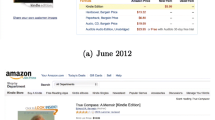Abstract
Conventional wisdom argues that all commercial and economic competition between two daily newspapers stops when they merge their advertising and printing capabilities to form a joint operating agreement (JOA). Clearly the JOA acts a monopolist in the sale of advertising, but there are two forces that may constrain the JOA to sell more advertising than a profit maximizing single paper monopolist would find optimal. First, there is the possibility of what is sometimes termed ``end game competition''. Disposition of assets from a JOA are often not determined until the JOA is near its termination date, and this may induce the weaker paper to maintain quality, both to improve its bargaining position and to keep open the possibility of remaining in the market as a competitor at the end of the JOA. Second, a daily paper arguably has to maintain a certain level of advertising and maintain a certain ``look'' and ``feel'' if it is to be considered a daily paper. This may constrain the JOA to sell more advertising and maintain a higher joint circulation than might be optimal for a single paper monopolist. We present econometric evidence that shows JOAs to have ad rates that are closer to those of competitive dailies than to those of single paper and 2-edition monopolists.
Similar content being viewed by others
References
Bucklin, Randolph E., Richard E. Caves, and Andrew W. Lo (1989) ‘Games of Survival in the US Newspaper Industry’, Applied Economics, 21, 631–649.
Dertouzos, James N., and William B. Trautman (1990) ‘Economic Effects of Media Concentration: Estimates from a Model of the Newspaper Firm’, Journal of Industrial Economics, 39, 1–14.
Fee, C. Edward, and Charles J. Hadlock (2000) ‘Management Turnover and Product Market Competition: Empirical Evidence from the U.S. Newspaper Industry’, Journal of Business, 73, 205–243.
Ferguson, James M. (1983) ‘Daily Newspaper Advertising Rates, Local Media Cross-Ownership, Newspaper Chains, and Media Competition’, Journal of Law and Economics, 26, 635–654.
Marketer's Guide to the Media 2001: Media Trends, Rates, and Demographics, V24. New York, NY: BPI Communications.
Reddaway, W. B. (1963) ‘The Economics of Newspapers’, Economic Journal, 73, 201–218.
Rosse, James N. (1967) ‘Daily Newspapers, Monopolistic Competition, and Economies of Scale’, American Economic Review, 57, 522–533.
Simon, Julian L.,Walter J. Primeaux, Jr., and Edward Rice (1986) ‘The Price Effects of Monopolistic Ownership in Newspapers’, Antitrust Bulletin, XXXI, 113–131.
Standard Rate and Data Service (1989–2000) Circulation. Des Plaines, IL.
Author information
Authors and Affiliations
Rights and permissions
About this article
Cite this article
Romeo, C., Pittman, R. & Familant, N. Do Newspaper JOAs Charge Monopoly Advertising Rates?. Review of Industrial Organization 22, 121–138 (2003). https://doi.org/10.1023/A:1022920018376
Issue Date:
DOI: https://doi.org/10.1023/A:1022920018376




